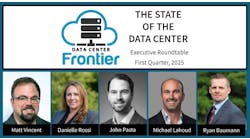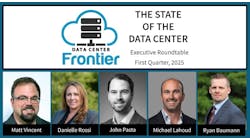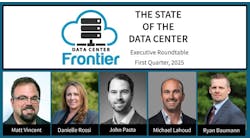Today we continue our Data Center Executive Roundtable, a quarterly feature showcasing the insights of thought leaders on the state of the data center industry, and where it is headed. In today’s discussion, our panel of experienced data center executives – James Leach of RagingWire Data Centers, Robert McClary of FORTRUST, Jack Pouchet of Emerson Network Power, Ted Behrens of Chatsworth Products, and David Shepard of BASELAYER – will examine how the evolution of cloud computing is changing the environment for data center service providers, and how mega-clouds and specialty clouds may develop in tandem.
The conversation is moderated by Rich Miller, the founder and editor of Data Center Frontier.
Data Center Frontier: The cloud computing sector appears to be entering a phase of more concentrated growth. How do you see the cloud evolving as a business, and how might this impact data center service providers and vendors?
James Leach: One day we’ll be reading Harvard Business Case Studies on the development of the cloud computing market – but not now, because we’re living it!
While much is still “to be determined” in the cloud, I think we can draw a few conclusions from these early innings.
JAMES LEACH, RagingWire Data Centers
First, the market can support a handful of large global cloud providers. The first ones have stepped up to the plate: Amazon, Microsoft, IBM, Google, and Oracle. This competition is good for everyone – suppliers and buyers. We can expect these companies to offer industry leading, global cloud services that reflect their core competencies, business models, and customer bases.
Second, there is a lot of room for hundreds, perhaps thousands of specialized cloud providers that use available technology and cloud services to deliver high touch, tailored solutions around application sets and industry verticals. In addition there will be armies of consultants and developers that build their practices on providing value added services to support cloud deployments.
The third take-away from the current cloud market is that “everyone loves hybrids.” There are hybrid clouds that cut across multiple cloud providers. There are hybrid enterprise IT shops that combine in-house data centers, colocation, and clouds. There are even hybrid start-ups that develop their applications and businesses in the cloud with the full knowledge that they will move to their own servers when they hit a certain critical mass of customers and usage.[clickToTweet tweet=”RagingWire’s Jim Leach: There is room for hundreds, perhaps thousands of specialized cloud providers.” quote=”RagingWire’s Jim Leach: There is room for hundreds, perhaps thousands of specialized cloud providers.”]
One thing is certain about the cloud market: data centers need to be ready to support the cloud every step of the way. We need global wholesale data centers to support the large, hyperscale cloud providers. We need flexible solutions to allow enterprises to map their IT systems to their business strategy. We need resilient, global telecommunications to interconnect data centers with each other and with the clouds.
TED BEHRENS, Chatsworth Products
Ted Behrens: The cloud is revolutionizing the distribution of software while enabling compute and storage as a demand based utility model. While this has led to massive growth within a subset of cloud service providers, the industry-wide tidal shift is fueling growth across most providers servicing this sector.
In coming years I would expect many vendors and service providers to pivot into specialized segments or niches that will both leverage the large scale cloud providers infrastructure but also layer services in order to meet the end-user’s business objectives.
Rob McClary: It has already impacted data center service providers, but not in the way many thought it would years ago. Many thought the cloud would disrupt the growth of data centers and negatively impact the colocation or data center provider industry.
ROBERT McCLARY, FORTRUST
The reality is that the cloud industry has given data center providers another vertical of customers, since clouds go into data centers. The cloud still represents hardware in a data center. Cloud providers are the great aggregators for data centers, bringing more compute loads and consumers into the fold.
Will it ever change and be as disruptive to the data center services industry as people thought it would be? I doubt it. It hasn’t proved to be in the five or more years we’ve been talking about it. Will it become a useful utility and managed service from a business standpoint? Absolutely. But three to five years from now, we might be talking about something else, like “wind computing!” In the meantime, you’re going to see a lot of different start up cloud businesses. That will evolve and at some point competition will drive consolidation in the market place.
When you say the cloud computing sector appears to be entering a phase of more concentrated growth, I would just call it predictable growth. In short, cloud is another customer vertical for the colocation data center. It has and will continue to grow.
JACK POUCHET, Emerson Network Power
Jack Pouchet: On the public side, we expect to see more, relatively smaller (2MW to 10MW) facilities being deployed to meet demand from users who want to know their IT assets are reasonably close by, even when they are in a pure cloud model. The on-premise private cloud model is also attracting interest as enterprise clients are finding new value in upgrading their legacy data centers for improved efficiency while embracing the benefits of cloud computing across multiple lines of business.
We have been able to demonstrate tremendous organizational value in “refreshing” a legacy Tier IV data center to bring the PUE down to the 1.3 to 1.4 range, while retaining all of the operational knowledge and expertise associated with the infrastructure systems. These types of facility upgrades bring new life to the building and organization, while establishing a truly robust, resilient, and high-availability cloud environment, fully contained within the confines of the business security and IP protection eco-systems.
DAVID SHEPARD, BASELAYER
David Shepard: The cloud market is maturing, and with that customers deploying the cloud realize that certain providers aren’t meeting all of their needs. In some cases, they’re having to deploy multiple cloud solutions to meet their needs, which results in a hybrid cloud solution – for example, part AWS and part private, all private, etc.
People are learning which applications fit better in each scenario. This knowledge is giving data center providers and vendors an opportunity to go to customers and help them with a hybrid cloud deployment. Modular data centers fit in perfectly here. They deploy rapidly, are scalable, can be built anywhere (in the parking lot of your office building), and then you can move any other services you don’t want onto your private cloud to AWS or Azure and continue to operate at a good service level for the end user.
Keep pace with the fact-moving world of data centers and cloud computing by following us on Twitter and Facebook, connecting with me on LinkedIn, and signing up for our weekly newspaper using the form below:











